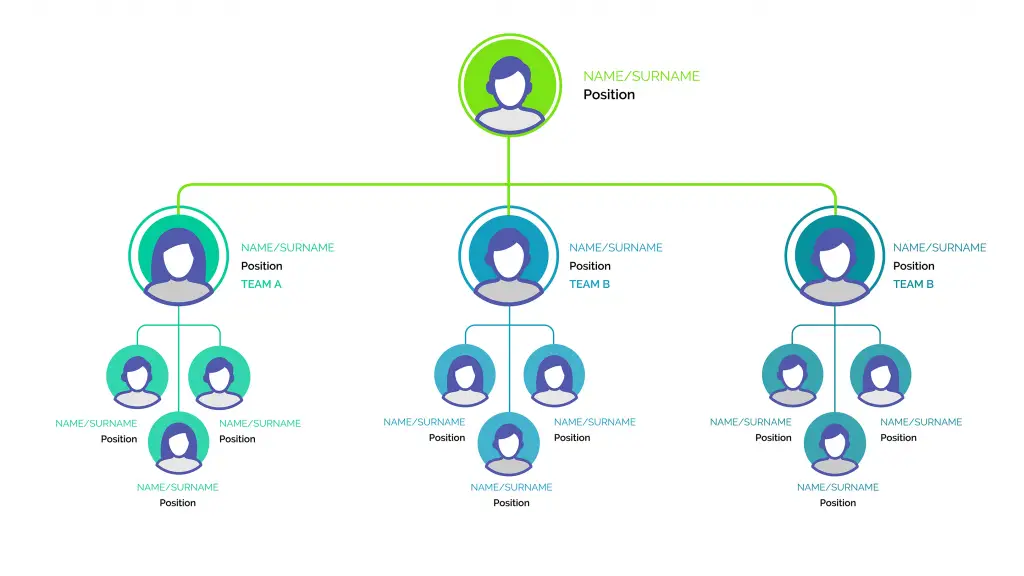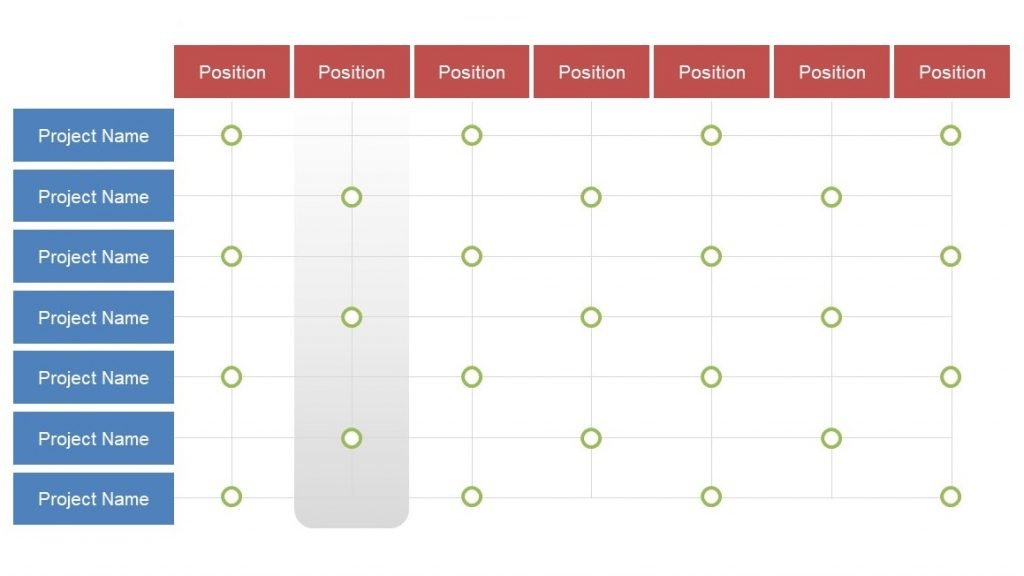This post contains affiliate links.
As companies follow the trend to flatten their organization chart, more and more are implementing matrix organizations where employees get instructions from multiple bosses. It is common for employees to receive direction from one or up to seven bosses in modern matrix structures. Knowing how to navigate competing demands will help you avoid frustrating mistakes and advance your career.

Matrix organizations provide many benefits as well several challenges: work overload, competing demands, and conflicting instructions. How to Succeed in a Matrix Organization has four main parts:
• Communication in a Matrix Organization
• How to Handle Conflicting Instructions at Work
• How to Handle Competing Demands at Work
• How to Handle Work Overload
Hierarchical Organization Structure: Modeled after the military, traditional businesses use a hierarchical organization structure with centralized command and control. Employees follow a chain of command, know where they fit into the structure, and have defined scope of authority and responsibility.
Matrix Organization Structure: By contrast, matrix organizations are based on the concept of networking and collaboration. Decision making is decentralized and employees frequently have more than one boss. Management in a matrix organization depends more on soft skills of consensus building and relationships than positional authority.


The familiar tree structure of traditional organizations is replaced by a ‘flat’ organization in a matrix structure. The strict chain of command is decentralized to break down silos and accelerate collaboration. Matrix structures are setup to be flexible and nimble for rapid innovation in dynamic business environments. Also common are hybrid structures where top leadership follows a more traditional org structure with many employee resources using a matrix structure.
Decentralized decision making means each employee has their own RACI chart or similar tools. RACI: Responsible for doing their defined work, Accountable for actions, decisions, and implementation, Consulted and provides input, and Informed with up-to-date communication. Each structure has pros and cons but we are going to focus on the keys to success in a matrix organization because there are many new challenges.
Communication in a Matrix Organization
Employees are supposed to feel more motivated and engaged in a matrix organization because communication is more open and everyone is doing their part to work toward an overarching vision. The reality is that a matrix structure with all of its solid line and dotted line reporting can also produce uncertainty about responsibilities, where decision authority lies, and a slowdown in decision making.
Communication is always important, but in a matrix organization it is absolutely vital. To be successful everyone needs to know what the desired outcome looks like. Frequent communication of shared targets, accountabilty, results, issues, and recognition of contributions keeps everyone aligned and reduces complexity and redundant effort.

Key leaders must be visibly held accountable for their individual group targets as well as the overall organization targets – this must always be both and never either/or. Office politics and the secrecy and deception that come with it are surefire ways to cause problems in a matrix organization. When people report to multiple bosses, interpersonal issues and conflicts of interest can arise. Transparent sharing of unbiased information is required.
The key is always communication. All significant issues, decisions, and results must be communicated with the key people involved using real-time information sharing like voice calls, text, or instant messages. Avoid email except for the lowest priority items. Your goal is avoid surprises and to keep everyone operating on the same page.
How to Handle Conflicting Instructions at Work
Whenever you get instructions from multiple sources there will always be disagreements. Some issues can be anticipated and you can take proactive steps to make the process go smoothly. There will always be unexpected issues that need to be handled after the fact. We cover both below with straightforward instructions and case studies to illustrate the key points.
How to Take Direction From Two Bosses at the Same Time
This situation tends to pop up when you are working on multiple projects and have leaders competing for your time. Another less common situation is when you are working on an item and they are steering you in different directions and both are think they have decision authority.

Stay Ahead of the Problem
Whenever possible, be proactive when dealing with multiple bosses and get ahead of problems instead of trying to play catch up. As soon as you know that you will be reporting to more than one boss, have the conversation with them about how to proceed when there is a conflict. The best way to do this is to make a proposal. To your bosses it shows that you are thinking ahead and providing solutions, while also setting the stage with your preferred result as the starting point for discussion.
Case Study 1: New Project With Two Bosses
For example, say you are an IT developer creating a new application for the Purchasing department. Logically you still have your boss in the IT department but for this project you also have the Director of Purchasing as a boss. You have already aligned on the scope of work and overall project timeline but you see there are still many details that will need to be decided. Your proposal might look something like this:
Hello Purchasing Boss and IT Boss
I am looking forward to working on this project, we are off to a great start by defining the deliverables and major milestones at the meeting yesterday. Going forward I anticipate there will be many more decisions that I want to work through effectively and efficiently. Here is my proposed framework for key decisions:
• I will route key decisions about the user interface and functionality to the Purchasing Boss as their team will be the primary users for this application
• I will route key decisions about database structure and server load to the IT Boss as their team owns the back-end support
• For decisions that impact both leaders (i.e. a server downgrade that impacts system response times, or a feature request that will impact the overall schedule) I will coordinate the decision with both of you, including a face to face meeting if necessary
• I will provide a status report update each week that includes all key decisions made to keep alignment
Thanks
Expert Employee
What is the Deliverable? It may seem obvious, but this question goes directly to the source of most conflict in matrix organizations. Deliverables need to be clearly defined – jargon and acronyms contribute to different members having different understandings of what is expected. Keep it simple and direct to the point.
Common Mistake to Avoid – Overstepping Authority: It is tempting to assign ownership to each leader and say ‘Purchasing boss will own decisions about the user interface and IT boss will own decisions about the servers’, but don’t do this. Bosses usually don’t like it when people they manage dictate terms because it looks like you are overstepping and undercutting their authority. Better to demonstrate your ownership of the issue and how you will get results (notice how all of the bullet points state what you will do), while still setting clear and reasonable expectations for everyone involved.
Common Mistake to Avoid – Not Communicating to ALL Key Stakeholders: The status updates with all key decisions is also vitally important. In this case the Purchasing Boss logically should be the primary owner for user interface decisions but the IT Boss still needs to know what is going on. For example, the IT Boss may be aware of a new company-wide initiative to standardize all of the software for the same look and feel. Learning about this as early as possible can avoid negative work re-designing the UI to meet the new requirements.
What is a Stakeholder? A stakeholder in this context is an individual or group that is affected by the outcome of a project or activity. They have an interest in the success of the project and will be impacted by changes to schedule, scope, or functionality.
Common Mistake to Avoid – Getting Caught in the Middle: You want to be solution-oriented and facilitate the decision between the two leaders, but don’t let yourself become they only communication channel. A good rule of thumb to remember is Don’t Strike Out. After two attempts are unsuccessful you need to try something else – i.e. if you’ve already gone back and forth between the leaders twice (strike two) and still don’t have an agreement for the same issue don’t do the same thing again – you will probably get strike three. Its time to change things up and get them together in a room. The same rule of thumb works for email, if you have already replied twice and there are still questions don’t send another email – find them in person or speak on the phone to resolve the issue.
How to Handle Problems After They Happen
In a perfect world we would be able to anticipate and prevent every conflict from happening, but we live in the real world and problems happen – the most important factor is how we respond. When you receive conflicting instructions from two bosses the best response is to deal with the issue immediately.
Case Study 2: There Can Be Only One
Lets say your job is painting cars, boss1 says paint it red and boss2 says paint it blue. In this example and many similar cases it is costly, difficult, or sometimes impossible to go back and change to the other option after the work is done. If you make your own decision and proceed you are automatically wrong in the eyes of one of your bosses.
Solution: This is a situation where you must stop until the disagreement is resolved. Don’t paint the car until both bosses sign off on the decision, preferably in writing so there is no question later.
Common Mistake to Avoid – Stopping All Work Completely: Many people use this situation as an excuse to do nothing. ‘Well I can’t proceed until this decision is made so I’m going on break’. Instead, look for opportunities to stay busy while the decision is made. You know the car still needs to be painted, so get everything else prepped and ready to go so there is no delay once the color is decided. Only work actually gated by the color decision needs to stop. If there really is nothing else to work on, then put your energy into facilitating the decision that is holding everything up. Find them in person for a face to face discussion, do any other legwork you can anticipate might be requested, call the meeting and clearly set the objective of deciding this roadblock.

Case Study 3: That’s Not MY Job
My neighbor had this happen to them. They were doing an extensive remodel so they hired a general contractor to help manage the trades. The tile guy started work and the homeowner gave them instructions for the pattern they wanted. A few hours later the general contractor checked in and told them to change some things. The tile guy just followed the new instructions, never mentioning that the homeowner was there earlier with different instructions that should be clarified. A simple phone call would have cleared up any discrepancies but later on when all three met the tile guy simply said ‘that’s not my job’.
Now its true that the homeowner and general contractor should be working to the same result and not contradicting one another, but misunderstandings and miscommunications do happen. The tile guy did get paid for the work he completed, but he won’t get any more work from that general contractor.
Common Mistakes to Avoid – Blindly Following the Most Recent Instructions: ‘That’s not my job’ is not a valid excuse in the workplace, even though it is frequently given as an excuse during post-mortem investigations of why an incident occurred. When there are obvious issues everyone has responsibility to bring attention to the problem so that the proper owner can take action. It seems like a basic item but doing it consistently is one of the best ways to advance your career.
Nobody wants to work with someone who just passively ignores obvious issues. In a workplace, everyone has ownership to recognize and resolve mismatch situations. It helps everyone work together effectively and efficiently and has a positive impact on team unity and morale. As an employee you should expect leadership will not be pleased if you know of an issue and passively stand by while a problem happens. Depending on how severe the impact was, leadership action could be in the form of coaching or disciplinary action and possibly termination.
How to Deal with an Inconsistent Boss Who Gives Conflicting Messages
Many situations at work evolve over time, especially on important and urgent projects involving many teams. New information comes to light that changes previous decisions and sometime the new directions are rolled out without enough explanation to understand the reason behind the change. This is a normal part of business and complaining about these situations will only hurt your career.
Please note that receiving multiple action items from your leadership is normal business and becomes a question of work prioritization, not contradictory instructions. Effective bosses bring clarity to their staff so they can take action with confidence, but there can be situations where your boss tells you to do something or do it a certain way and then later says that was incorrect.

Keep Good Notes
Large meetings should always have meeting minutes to capture decisions, actions items with commit dates and owners, and other key information should be recapped before the meeting adjourns and published to all stakeholders. For smaller and informal meetings, minutes are not always practical so instead take notes to capture key decisions and instructions, then reference them while doing your work.
Everyone gets busy and is juggling multiple different activities so having different recollection is frankly normal. Later if there are questions you can speak with confidence ‘we decided to do x, here is where I wrote it down’ and that will be enough to satisfy most people.
Expert Tip: For situations where your boss either won’t accept your notes or a pattern develops where your boss repeatedly contradicts themselves you will need to take additional steps to get their directions in writing. When possible communicate by email – and save your emails to avoid he said/she said situations. Even if the instructions were delivered verbally, send a follow-up email to capture what you understood was requested. This creates a paper trail in case you need it later.
Ask Questions to Understand Why
If the only feedback you receive is that you made a wrong decision it will be very difficult to make improvements. You need to have enough information to know why the wrong result happened and how to implement improvements. Try to keep your conversations constructive, it is OK to ask why something changed if you genuinely want to understand and then help the team adapt and overcome. It is OK to be frustrated sometimes, but repeatedly asking questions with a sarcastic or negative tone don’t help your team and will hurt your reputation.
In many cases, the friction develops because teams are looking at their own priorities and feel like they are getting jerked around for no reason. It can be very demotivating to pull out all the stops and complete a major milestone only to be told that its no longer needed and now the company needs this other deliverable. When that happens it is important to take a step back and look at the bigger picture – how does this fit into the project overall? Sometimes certain areas feel the squeeze in order for the larger scope to be successful.
Common Mistakes to Avoid – Arguing About the Change: There is a time for discussion and there is a time for action. Rarely will decisions be unanimously supported by everyone affected, but the decision is made by the authority it is everyone’s responsibility to support the decision. Ongoing debate after the fact only serves as a distraction unless it is genuinely being done as part of risk mitigation activities. Get on board and put your full effort into making progress, if it was really a bad decision then the best way to convince people another change is needed is to actually see the impact.
In some cases people can be very committed to the previous ways that they refuse to accept the change. Change management is one of the biggest challenges and a frequent topic of leadership books (here is one of our favorites, buy on Amazon) so there are no easy answers. However, you need to have a willingness to accept change at work, it is inevitable.
How to Handle Competing Demands at Work
We’ve all been in the situation where you are working away doing your job and somebody comes in with a request. Usually they give it urgency by saying ‘this is hot’, ‘this is critical path’, or my favorite is when they go overboard with the adjectives ‘this is super mega volcanic uber hot’.

Accommodate the request if you can do so as part of your normal responsibilities and without impacting other work, but this is rarely the case. Bumping another items to the top of your to-do list almost always means that something else will get delayed. Frequently the importance is overstated – their boss lit a fire under them and they are trying to make up for it, but how do you determine when to drop what you are doing and jump on the new actions?
The following content works equally well for traditional organization structures as well as matrix structures. Even though matrix structures have many solid line and dotted line connections, in actual operation functional teams form naturally. Even in a matrix, you know who your ‘real’ boss is – they approve your time off, deliver your performance review, and make decisions about your compensation. Even if many people have input, just one boss will typically be responsible for these items.
When the Request Comes From Outside Your Team
When the request comes from outside your team (from another department for example). Continue working your existing priorities and help route the request through the normal decision channels. These are normally routine functions and your team probably has established methods for how they are handled, either by precedent or sometimes even written procedures for complex issues. Common examples are ‘all priority changes go through the shift supervisor’ or ‘project scope changes must be approved by the project lead’. Someone from outside your team may not be familiar with how you operate so inform them of how to get their request to the proper decision maker. ‘That request needs to go to John, here is his contact information’.
When the request comes from a senior leader outside your team (from the the director of another division for example). Get your leadership involved immediately. A great way to do this is right when you receive the request let the external leader know that your leadership team needs to be part of the conversation and decision. No leader wants their team to be pulled in many different directions by other teams so the external leader should fully understand this, although if they come to you directly they have already bypassed the normal process.
Once you have your leadership talking with external leadership they should reach a decision, but don’t be surprised if that decision means that both tasks need to be completed with no change to the deadlines – it happens all the time. Engage with your boss to figure out the plan of attack and offer constructive suggestions for what to do. These situations are rarely all-or-nothing so an action plan that satisfies 85% of the request is frequently welcomed. You may feel like you are getting dumped on, but remember your boss is getting dumped on too so don’t play the victim.
Common Mistake to Avoid – Not Being Helpful: Coworkers from another area may not be familiar with the work procedures in your area or how to get their request routed to the right person. Don’t just tell them they are doing things wrong, help them navigate the requirements. It is easy to just keep your head down in your work and let them struggle, especially when you are already busy. Instead, take a couple minutes to explain what they need to do, who they need to meet with, or where they need to go – you never know when you will be that person looking for a friendly face to help you.
When the Request Comes From Within Your Team
When the request comes from within your team (from your boss’s boss for example). Start working the new request and let your boss know about the change. ‘Hey boss, letting you know that big boss made these changes’ and then give a summary. Always state the impact of the new directions so that your boss and big boss don’t get surprised. For example, drop x and do y instead, add x to the scope of your work, do x first and then y (y is delayed from original plan),

Case Study 4: Different Priorities
Lets say your job is making widgets, you can make either widget1 or widget2 but you only have 1 machine and each job takes 10+ hrs once it starts. You arrive to work in the morning and read your emails, boss1 says widget1 is your top priority and boss2 says widget2 is your top priority. This is a difficult scenario because the requests are mutually exclusive, once you start a job it is not easy to switch, and any delay time is lost forever.
Solution: This problem landed in your lap, but now you own it. You need to get in contact with both bosses immediately to resolve the conflict. A group text can be an effective way to reach out to both leaders, explain the situation, and state why both requests are mutually exclusive. For this case you can and should provide the impact of both options – if I work widget1 first it will finish at this time, widget2 will complete at this time (and vice versa). By laying out the facts you make it easier for the bosses to understand the situation and deliver a decision.
When only one boss responds you might expect to always work their requests first, but this doesn’t happen. Good bosses look out for the business first so give them the context of the situation. Share what you know about the other request and why it has urgency – leaders have access to more information and they may be familiar with the other work or they may be able to help reach someone else in the organization.
Discuss it together and reach a clear decision and then communicate it out. Use the same method – if you started with a group text, send a follow-up group text to the same people. The boss that responded will see your message and can correct any miscommunication and the boss that didn’t respond will see the thread and know what decision was implemented.
What if you get no response from anyone? You should try reaching out to their bosses or other senior members (as appropriate) but even so there will be cases when nobody replies. Doing nothing is always the wrong answer because of the lost equipment time, so you have to make the decision. My advice is always go with what you know, when you know widget1 is for an important client that was talked about during a team meeting and you don’t know why widget2 is urgent then get going on widget1. Send follow-up communication to let both bosses know what is happening.
Boss1 and Boss2
I tried calling and texting to clarify the priority but wasn’t able to reach you. Waiting longer would just delay completion for both requests so I started processing widget1 and it should finish by x:xx pm. Widget2 is next in line and should complete by y:yy time. Will keep you updated with any changes. – Expert Employee
Common Mistake to Avoid – Being Combative or Defensive After the Fact: If you don’t hear back from one or both bosses there is a chance that they will be displeased with the result. Good bosses will recognize their own responsibility for the lack of information sharing and them being unavailable for questions. But even good bosses can get fired up when things don’t go as they expected. Try to remain calm during the discussion and keep the focus on the issues and not the people. Throwing around statements like ‘I can’t do both requests at the same time!’ or ‘Well, if you had called me back this wouldn’t have happened!’ – you need to stay constructive. Look for solutions about how to handle the current situation.
Now anyone can make a decision that gives the wrong result, but as long as it was a logical choice given the information available then that decision is defensible. It may not have been the optimal path, but it is the process that needs to improve. Experienced leaders know to establish procedures for how to handle regular work and the exception cases. These situations can be a good opportunity to write down the procedures for everyone to reference and be sure to implement preventive countermeasures to eliminate a recurrence of similar events.
How to Handle Work Overload
Work overload is real in traditional organizations where an employee only has one boss that presumably is more in touch with how much is on each person’s plate. Add one or more bosses, each pushing their own priorities and agenda, and it is easy to see why work overload is one of the most common problems reported by employees in matrix organizations.
Sometimes people can be so overloaded that there is intense competition for their time just to attend meetings and conference calls, let alone actually get any work done. In these situations be sure to share your calendar so everyone can see for themselves when they try to schedule a time.

Be Forthright About Your Workload
If you hide how overloaded you really are, there is not much anyone else can do to assist. When you get a new request be open about where it fits in your priority list and give a realistic estimate for completion. During your regular check-in meeting every two weeks discuss this with your boss – they need to be aware and may even have some assistance to offer.
The best action is preceded by the best decision
Prioritize
One of the easiest traps to fall into is working on the item for the person that makes the most noise instead of the action that has the most impact. There are many prioritization methods out there but I recommend the Eisenhower Decision Matrix, also known as the Urgent-Important Matrix and popularized by Covey in The 7 Habits of Highly Effective People.
| Urgent | Not Urgent | |
|---|---|---|
| Important | DO Do it now. | DECIDE Schedule a time to do it. |
| Not Important | DISTRACTION/DELEGATE Time wasters or Find who else can do it if truly necessary. | DELETE Eliminate it. |
- Important and Urgent: These are emergency items are that can not be ignored without serious consequences. For example a major customer is threatening to cancel their order and you have a meeting with their president in an hour. Some issues pop up unexpectedly and need to be handled, others are the result of procrastination. ‘Fire-fighting’ activities fall into this category and can be very disruptive to overall productivity because of how much energy and resources they consume.
- Important but not Urgent: Ideally this is where the majority of your work activities are spent – making progress on actions important to long-term success before they become emergencies. Just about every work function should be in this category but these three illustrate the concept well: training, strategic planning, and completing preventive maintenance on-schedule. When you stay on top of these items you avoid later problems.
- Urgent by not Important: Frequently these items seem to also be important but consume a lot of time but really don’t add enough value. Keeping a clean email inbox and attending a meeting ‘just-in-case’ when you do not have an item on the agenda are examples of this category. Many office conversations, text messages, and group chats fall also belong here – they interrupt your work and distract you. Turn off notifications so you can concentrate on your work and let key people know how to reach you for real emergencies.
- Not Important and not Urgent: Browsing photos of the last company party, scanning social media, studying the menu to figure out whats for lunch, watching the latest cat videos… You know all the ways you procrastinate and waste time, eliminate them as much as possible but still give yourself enough down time to avoid burnout.
Common Mistake to Avoid – Prioritizing Without Input From Your Boss: Your boss always needs to be part of your prioritization process. This should happen naturally as part of your everyday activities but is vitally important when you are overworked. Given the chance, we tend to focus on the work that we want to do and that may not be the most important work for the company. Your boss will have additional perspective to make the decisions, and they do write your performance evaluation after all. Also, very few employees have the autonomy to drop assigned work, make sure your boss is included in those decisions.
Communicate Early and Often
When you are overloaded you know that some items are going to slip and miss deadlines or commit dates. It may seem counter-intuitive at first, but time is your friend in this situation. Early communication to the stakeholders of expected delays or difficulty in meeting the deliverables gives the time to implement contingencies. The more time remaining, the more options remain viable to mitigate the impact. Other members can pick up the action and share the load, downstream owners can adjust to the new schedule and not be surprised by delays.
Common Mistake to Avoid – Not Communicating the Risk Before the Due Date: Nobody likes to tell their coworkers that they won’t be able to complete something because we think it will reflect poorly on our performance. We all have the thought ‘If everything works out perfectly I can still make it, I don’t need to share my failure yet’ but nothing every goes perfectly. You have to be realistic because life happens, there will be home priorities that interfere, new business items that take away time, and there will be problems and delays that you can’t anticipate. In fact, this is still a good time to have the conversation (a little bit earlier is ideal) with your team to let them know this item doesn’t have any margin for error. If it is on the critical path then it will impact the overall project.
What is Critical Path? The critical path is the set of most important tasks or milestones that, if missed, will delay your entire project. A simple example of this is making a lasagna – you can prepare the noodles, cheese, and sauce one-by-one or in parallel but all of them must be ready to start building the layers. If any one of them is delayed the entire dish is delayed because they all need to be combined before the lasagna can be baked.
The reality is that nearly everyone juggles multiple projects and will need help at times, the professional way to handle it is to let your project team know the situation. Now if you have a pattern of repeatedly missing deadlines because you procrastinate important work then you are right to be concerned, your actions do have consequences.
Set Boundaries
It can be tempting to just work crazy hours and power through to get things done, and this may be necessary in the short-term. Recognize that everyone has their limits for what they can sustain long-term and take steps to prevent burnout. Every workplace has its own ‘busy period’ when distractions are at their highest from other coworkers – try shifting your schedule to come in early or stay later so you can work more productively with fewer distractions. Multitasking is a myth!
Reserve time on your own calendar to give yourself time to work without others seeing you as ‘available’. Logout of email and set your phone to silent so you can concentrate on your high priority activities. Work in objectives that you expect to take about 30 min and stay on that one item until it is complete, then move on to the next.
Common Mistake to Avoid – Making Incremental Progress on Several Items: When you are behind and overloaded you will have several people requesting their deliverable and asking for updates. Rarely does it make sense to do a little work on many different items just so you can show some progress to each of them. Instead, work on the most important and urgent item and make meaningful progress on it; provide realistic updates to the other stakeholders. You won’t make everyone happy, but if you have prioritized with your boss this is the correct course of action for the company.
Say NO
It should be clear by now that you don’t have unlimited time and energy to satisfy every request, so take a hard look at new requests. From the Eisenhower Matrix, stop doing low-value activities and meetings are a common time sink. Here are good rules of thumb to evaluate if you are needed at a meeting:
- If you sit through any meeting without speaking then you don’t need to be there
- If you don’t have an agenda item you don’t need to be there (read the meeting summary)
- If the meeting doesn’t have an agenda then request one, if no agenda is provided then do not attend
- Most meetings where the purpose is to ‘review results’ or ‘share information’ are better handled by email
- Continue to attend meetings where you are needed to make a decision, request those agenda items happen early during the meeting and then leave when they are completed
Don’t Cancel Vacations Already Approved
You’ve made the reservations months in advance and your boss approved the time off, but new projects came up in the meantime and now everything at work is super busy. You feel like you are letting your team down if you step away from work to take your vacation. The fact is nobody should be irreplaceable at work, if they are then that is a major flag that the operation is not well run. Anyone could be out unexpectedly due to family emergency, an accident, or an illness and the business needs to continue running. Planned vacations are necessary to reset and re-energize so don’t cancel your plans except for extreme emergency situations.
Expert Tip: A common saying in management is ‘What if they get hit by a bus?’ to drive preparation of redundancy and contingency planning. I prefer a more positive view ‘What if they win the lottery?’ because either way they probably won’t be in to work afterwards.
